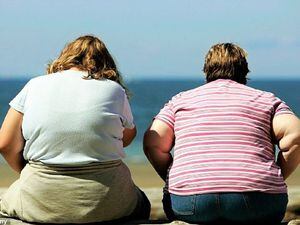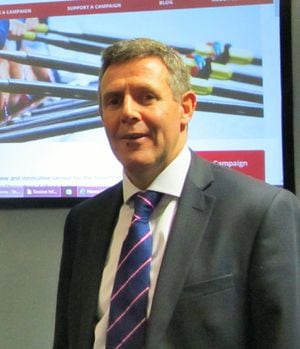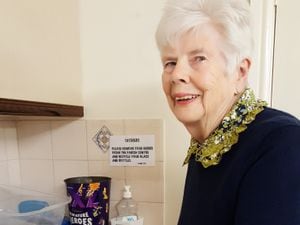Time to take on Shropshire’s hidden killer
With 750 deaths from lack of exercise reported each year in our region alone, a new strategy is being launched that could literally be a lifesaver

John Buckley paints a pretty grim picture about the county's health.
"Seven-hundred-and-fifty deaths per year in Shropshire, Telford & Wrekin, are due to inactivity," says the professor of exercise science at Shrewsbury University Centre.
"That's equivalent to two jumbo jets crashing every year in Shropshire."
Does that mean we are a county of couch potatoes? While this is problem by no means unique to Shropshire, it is fair to say that the county has its work cut out getting people to lead more active lifestyles.
Prof Buckley is at the Enginuity museum in Coalbrookdale, for the launch of a new campaign by the Energize keep-fit charity to make people in the county more active.
He says there is a certain irony in the choice of location.
"As Ironbridge started the Industrial Revolution, it can be considered the birthplace of physical inactivity," he says ruefully.
"For millions of years humankind learned that to conserve energy extends lives and following the last two hundred years since the Industrial Revolution we’ve now reached a situation where conserving energy is actually beginning to be detrimental and shorten lives."
He says 143,000 people across the whole of Shropshire, including Telford & Wrekin, are classed as 'inactive', accounting for 29 per cent of the population. But for those aged 55 and over, the figure rises to 42 per cent. And it's not just he older generation either. Eighty per cent of children aged five to 15 are classed as not active enough to maintain good health.
The figures have led Energize to rethink its strategy. Since it was formed in 2012, the charity's focus has been promoting grass-roots sport by providing support with administration and marketing, and helping sporting organisations to access public funds.
But chief executive Chris Child says the statistics show there is a clear need to target specific groups, and focus on those who are more likely to spend their spare time on the sofa than in the gym.
"Our new strategy puts more emphasis on those who are classed as 'inactive', which is between a third and a quarter of the adult population.
"Although more people are taking part in sport since the 2012 Olympics, and some sports and activities are showing growth in participation, it's largely thought that a different approach is needed."
The organisation has identified four different target groups: families with lifestyles that might mean youngsters are less likely to lead active lifestyles, the 13-25 age group, the 45-70 age-group where a lack of activity may store up problems for later life, and the elderly, where an active lifestyle could be crucial to them retaining their independence.
Of course, there are plenty of organisations across the county which are already doing this: for example, Sports and Arts in the Community, based at Bishop's Castle Leisure Centre, provides a comprehensive range of sporting activities aimed at youngsters during the summer holidays. The Shifnal-based Live at Home charity is planning to launch a chair-based exercise class with a view to helping older people lead more independent lives.

Mr Child says identifying groups which are already working to deliver such objectives will be crucial to the strategy's success.
A walking netball group, which provided a new lease of life to a woman in her 80s, and the Breaking Chains cycling club, which uses the sport to help addicts overcome their dependencies, have been cited as examples of how the charity could potentially encourage hard-to-reach groups active in sport.
Another group which, perhaps unsurprisingly, suffers from high levels of inactivity, are those living with disability or long-term health problems. Mr Child says that 43 per cent of people with long-term conditions are considered to be physically inactive, compared to 21 per cent of able-bodied people. He says for the past four years, Energize has been using lottery money to support groups which encourage physical activity among the disabled.
Children from families which suffer from deprivation have also been identified as more likely to be inactive, with 16 areas across the county – 15 in Telford & Wrekin – falling within the 10 per cent most deprived in the country.
Ben Harper, of Energize points out that one in five children in Shropshire are overweight by the time they start primary school, rising to on in three by the time they leave.
"Over half parents of these children would describe their children’s weight as ‘about right’," he adds.
"Families within lower socio-economic groups are much less likely to be active."
Mr Harper says there is no typical family, with each facing its own challenges, but crucially children are far likely to lead healthy, active lifestyles if they see their parents doing so. If there parents are chain-smoking couch potatoes, one should not really be surprised if the youngsters follow in their footsteps.
At a time when the NHS is facing ever-growing demands on its limited resources, Mr Child points out that helping people make just small changes to their lifestyle could bring huge benefits to the public purse.
"It can be a really cost effective," he says, adding that research suggests that every £1 spent on encouraging people to take up walking or cycling can save £19 in the long-term.
"There are huge pressures on some of the acute and statutory services right now, and if we are genuinely going to help people become less dependent, I think encouraging an active lifestyle – doing something for yourself – could really help."





